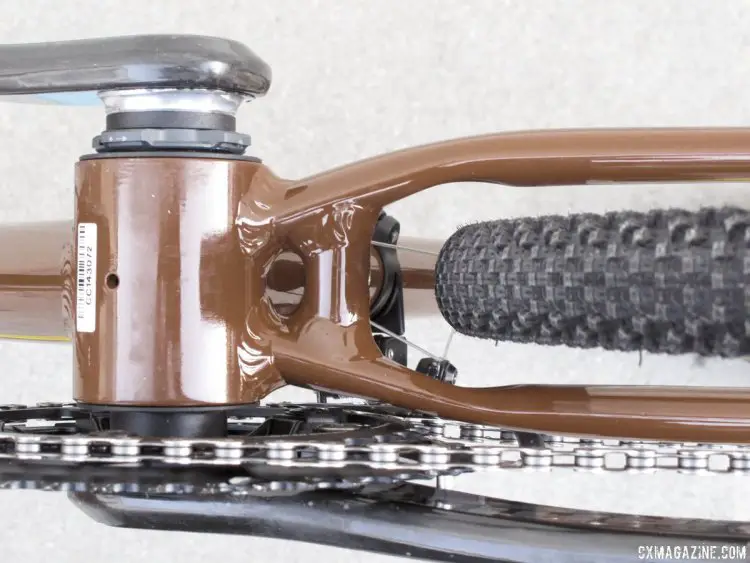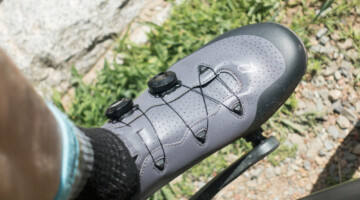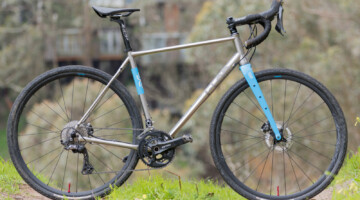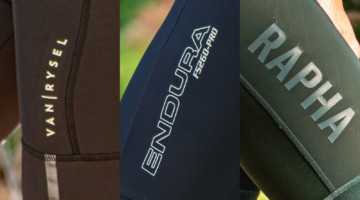The Ride:
The Ritte Crossberg is an attractive package, both for its aesthetics and its value. Let’s first discuss what matters arguably the least in terms of performance: The paint scheme is milk-chocolate brown and sky blue. That certainly sets the bike aside from others we’ve seen in the recent past—something that is attractive in and of itself. Aluminum is making a bit of a comeback, but podiums are dominated by carbon fiber. Ritte is relying on its reputation of producing performance bikes that aren’t trend-followers, and the paint scheme and branding help the bike stand out.
Aluminum as a material gained a reputation for harshness during the late 1990s, but prior to that, aluminum was considered too soft, as anyone who rode or raced an Alan or Vitus back in the day would attest.
With smarter engineering, aluminum can be an ideal material for bike-building: It’s not expensive, it’s generally easy to work with and produces a lightweight product. The Crossberg embodies all those qualities: nimble, light, smooth and efficient. Altogether, it’s a ride that matches the best race bikes. It does nothing wrong and is a joy to ride and race. Over the roughest terrain, the Crossberg dampened the track reasonably well, certainly better than some of the carbon bikes that have rolled through Cyclocross Magazine’s office. It has a smooth quality similar to a steel bike, but with a different resonance. I thought that was remarkable for an aluminum bike, given the material’s reputation.
We’ve said it before, and will say it again, in cyclocross, tires and geometry (including fit) play the biggest role in ride quality, and the Crossberg Disc helps with the second part of that equation.

The Ritte Crossberg offers more than fair space for a wider tire. © Clifford Lee / Cyclocross Magazine
Though one might think otherwise, the slack head tube angle does not affect handling in any significant way, but the resulting longer front center does offer a bit more toe clearance if you’re swinging the front wheel around on a slow, uphill switchback or in the parking lot. Maybe that half-degree of slackness adds some stability, maybe it slows steering or maybe it adds to the smooth ride, but none of those stereotypical qualities of a slack head tube angle stand out, and neither is there any wheel flop.
The 6.5mm bottom bracket drop is right where modern cyclocross bikes seem to have settled, and only if you’re used to riding an old-school, higher-bottom bracket over rough terrain will you really have much to complain about here. The Ritte Crossberg geometry is pretty typical of modern cyclocross bikes, and is well-suited for both cyclocross racing and mixed terrain adventures.
Ritte is based in Southern California, which is in the middle of a historic drought, but don’t assume the designers didn’t think about mud. There’s plenty of clearance for muddy days in case the storm of a century finally hits, or if you hope to race the bike over in Belgium (or Portland) for some epic mud.
Hope to do more than just race cyclocross events? You’re in luck. The Crossberg can easily accommodate 38c tires with a bit of clearance, or possibly fatter rubber, depending on tread and rim widths. There are also two bottle mounts to wash the gravel out of your mouth. Need fenders? Find the strap-on variety, as there aren’t mounts on this bike.
Finally, the Crossberg can be built up however you want, but our sample came with SRAM Force 22 Hydro, which performs solidly with fast shifts with solid lever feedback. Missed shifts are user error, as the actual shift mechanism is nearly flawless both front (with SRAM’s Yaw technology) and rear. The HydroR brakes and levers are superb. I like the tall lever: It adds another grip location, and the minor lever redesign of 2015 is slightly more comfortable.
Lever stroke is smooth and progressive, offering excellent modulation and ultimate power. Hydro R requires moderate lever force to pull a hard stop, especially when braking from atop the hoods, so don’t think it’s the panacea for long, steep descents while holding the hoods.



























